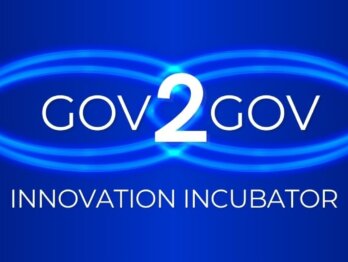Stewarding Innovation Portfolios for Collective System Change: Examples from Practice

Innovation portfolio management is becoming a core practice for intentional and proactive public sector innovation units to prepare governments to address a diversity of current and future challenges.
The practice:
- Helps build clarity of purpose of innovation;
- Provides a high-level view of the interrelationships between innovation support activities;
- Identifies gaps and prompts for ideas for changes in direction or composition; and
- Identifies the types of innovation supports needed to steward the whole portfolio.
But the challenges that governments face now and in the future will increasingly require collective action by others. Innovation portfolio management must become an activity beyond organisational boundaries.
Our recent webinar ‘Stewarding Innovation Portfolios for Collective System Change’ explored the role of governments and institutions in stewarding innovation portfolios among an ecosystem of actors, including emerging strategies for catalysing and sustaining collective system change. It aimed to present OPSI’s research and theoretical framework on innovation portfolios and to share emerging challenges and practices by convening public sector professionals working in this area.
What is innovation portfolio management?
At the OECD Observatory of Public Sector Innovation (OPSI), we look at innovation portfolios from the perspective of the innovation facets model. While it is far from the only framework in use for innovation portfolio management, we find it consistently valuable in our interventions with governments. Some other example frameworks and approaches are included at the end of this blog.
Balancing innovation portfolios in practice
We explored emerging practices and challenges in innovation portfolio management through two case studies. Olle Armstrand Dierks, Kateryna Pereverza and Åsa Minoz presented their work at the Viable Cities project in Sweden. Katarina Scott and Emily Wise spoke about their experience at Future by Lund in Sweden.
Viable Cities
Olle Armstrand Dierks, Asa Minoz, and Kateryna Pereverza manage innovation portfolios for a living. Olle is the Portfolio Strategist and Asa the Innovation Strategist of the Swedish strategic innovation programme Viable Cities. Kateryna works as a researcher in sustainability transitions and transformative innovation policy at the Viable Cities Transition Lab. The Viable Cities portfolio has a twelve-year budget of 100 million euros, funded by the Swedish innovation agency Vinnova, the Swedish Energy Agency, and Formas, a government research council for sustainable development. The programme has 100 member organisations representing the quadruple helix governance model (that is, it consists of funders, public organisations, academia, and civil society).
The flagship initiative of the Viable Cities programme is an effort initiated by nine Swedish municipalities in 2019 to become “climate neutral cities by 2030 with a good life for all within planetary boundaries”. From October 2021, this will be expanded to 20 cities in Sweden. To achieve this target, the Viable Cities programme uses a mission-oriented portfolio strategy.
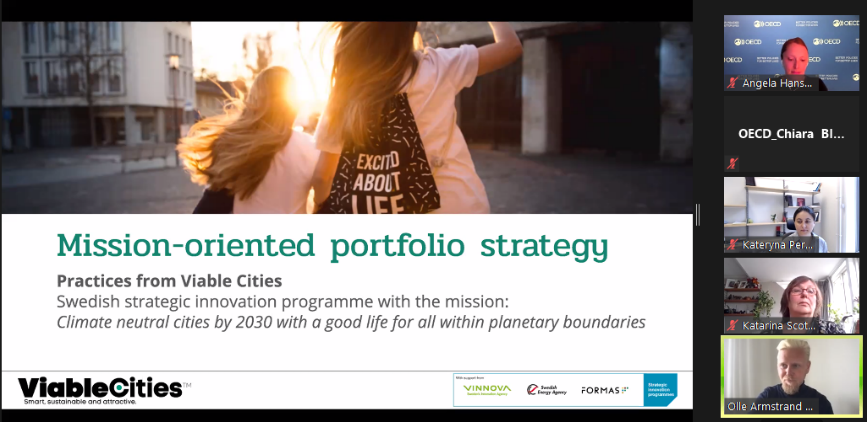
Viable Cities has adopted a portfolio approach because it works on the assumption that all innovation initiatives run by an organisation or ecosystem need a direction, whether at a national or organisational level. Asa explained that the portfolio approach addresses problems of fragmentation, projectification, and silos by introducing directionality, reflexivity, coordination and investments.
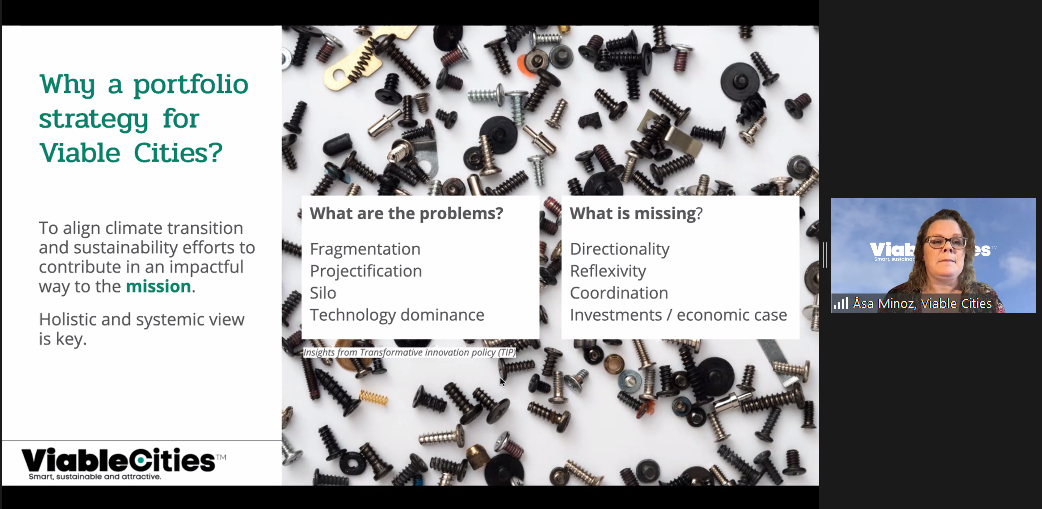
The purpose of the portfolio is to align and coordinate the multiple and complex sustainability and transitions efforts needed to reach climate neutrality. Olle’s observation is that considering an organisation’s or ecosystem’s innovation activities as an innovation portfolio helps to orient them towards a common goal. In the Viable Cities programme, the mission to become climate neutral provides this directionality.
Olle explained that after establishing a direction, portfolio managers must next address the structural barriers to reaching the target – policy impediments, lack of organisational capacity, or underlying paradigms. Working closely with people and organisations with high levels of commitments to the mission, the portfolio strategist’s role is to ensure that various innovation actors can come together to create a movement for change.

Portfolios of what?
Kateryna admonished that portfolio managers and researchers must challenge inherited conceptions of what a portfolio is: what types of activities should be considered part of the portfolio to be monitored and managed? She found that rather than equating portfolio management with simply listing innovation projects and programmes, “a transformative portfolio can also include challenges, needs, barriers and promising options towards the [portfolio] mission. Other elements could be investment plans, learnings and people.” Viable Cities defined seven dimensions of portfolios that portfolio managers should take into account:
- Portfolio (co)-ownership: who oversees and owns the overall portfolio as well as its component parts.
- Portfolio logic: what drives portfolio activities.
- Portfolio elements: what activities are part of the portfolio.
- Nature of relations between elements: how objectives, teams, and activities are linked.
- Leverage mechanisms: how objectives, teams, or activities in the portfolio can be strengthened or transitioned.
- Categories of impact: what outcomes the portfolio approach targets (e.g., a greater number of innovation activities, or better alignment between efforts).
- Portfolio-building practices: how better portfolio coordination and collaboration can be supported.
By broadening the concept of what the innovation portfolio comprises, Viable Cities can build a common understanding of transformative change levers among stakeholders.
Future By Lund
Katarina Scott and Emily Wise brought us another example of innovation portfolio management from Sweden. Katarina is a project manager and Emily an action researcher for Future by Lund, an innovation platform, affiliated with the University of Lund, that supports the Swedish city of Lund. As a smaller city with a large student population and various innovation actors, Katarina says that the innovation environment in Lund is naturally fragmented and there are no centralised decision makers: organisations operate under their own logic.
As in the case of Viable Cities, Future by Lund uses the portfolio approach to make sense of innovation efforts and to connect ideas with resources. Future by Lund uses the Portfolio Exploration Tool developed by the OECD OPSI, which contextualises and visualises innovation activities across four innovation facets (see image below; you can read more about how Future by Lund uses the Portfolio Exploration model here). The model functions as a pedagogical tool for creating shared understanding in Lund’s multi-stakeholder governance environment. It clarifies what is happening and who is doing what in the portfolio. The portfolio approach combines various perspectives and stakeholders across thematic areas (e.g., innovation towards climate neutral cities) and geographical lenses (e.g., innovation in regional development).
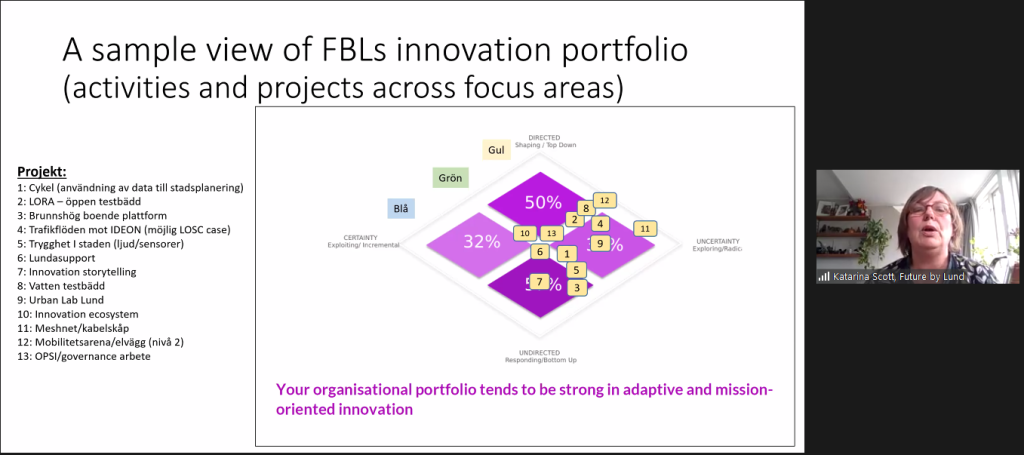
The mapping of innovation activities and relationships means that Future by Lund is able to help connect projects to “innovation assets”. That could involve connecting innovation actors with expertise, peer organisations, or funding. The unique perspective of Future by Lund as a portfolio system steward means that Katarina and Emily are able to assist innovation actors in aligning resources: national, EU-level, and local financing, as well as seed, investment, and private funding. In her unique position as portfolio manager, Katarina is able to track the movement of projects over time and innovation approaches over time. For instance, she observes whether particular initiatives or the city’s innovation activities in general are more focussed on innovation that adapts to immediate needs (adaptive innovation) or innovation that looks at long term trends (anticipatory innovation).
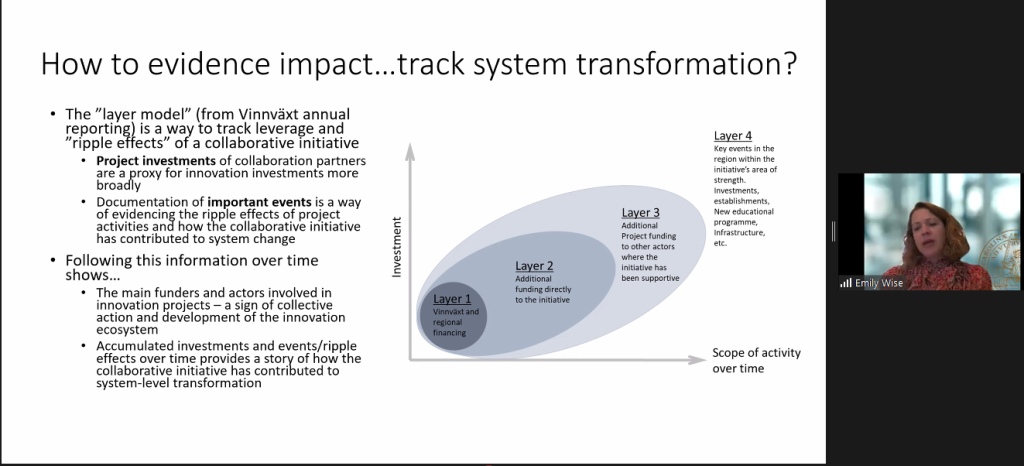
Through the portfolio approach, Katarina and Emily support the platform’s leadership with critical reflection and feedback to support learning and development. They help ensure quality in the follow-up of results and also contribute to learning activities at national level along with action researchers of the other innovation platforms.
Challenges in innovation portfolio management
In a panel discussion, we discussed emerging challenges in innovation portfolio management based on our key research questions. A summary of the discussion is below.
What is your role as an innovation portfolio steward?
- Viable Cities see themselves as ‘mission drivers’: the intermediation role is at the core of their work. Their role is to connect people and connect to other portfolios; they coordinate, analyse, and push the portfolios in certain directions. The key element is to put a high emphasis on the cities in the widest sense: innovation portfolios should be needs-driven by municipalities.
- Future by Lund have the important role of asking partners what they need or help them understand their needs. Their facilitation role is to know when to push and when to hop off. It is important to know that innovation stewards in Lund do not own anything – they are neutral, they do not have a budget, and they do not create anything. From this position, Future by Lund is able to track ideas for relevance and potential, move things, and provide pushes in the right direction. The team also works to build the social capital among innovators to ensure an effective ecosystem.
How did you decide on the mission-oriented approach that sets the direction for the portfolio?
- For Viable Cities, the setting of the mission came first and this decision was agnostic of the methodology chosen for implementation. Within the mission, Viable Cities selected specific challenge areas important for the portfolio transition. One of the challenges was around the future of mobility. Finding solutions that are more technology-oriented were on the lower end of the innovation priority list, but the real challenges were the policy or investment barriers to innovation. Transparency was important to connect purposes and initiatives between portfolios.
- Future by Lund has found that most organisations have similar missions or aims. By understanding how different organisations’ visions align with others, agendas can be connected. Very often, the connections are blurred because organisational drivers are not clear outside of organisational boundaries. The political decision making processes in place can vary across regional, municipal or national contexts and innovation portfolio stewards must approach partners in the ecosystem with humility and willingness to convince actors in different frameworks of a shared purpose.
How does innovation portfolio management work in a multi-stakeholder environment?
- While Viable Cities targets Swedish cities seeking carbon neutrality, 99% of innovations on climate neutral transitions happen outside of Sweden. Viable Cities has worked with various national and international partners to understand the global value chain: among them were Nesta Challenges, UN Habitat, local governments, the world expo in Dubai, and new government agencies that they had not worked with before. Once these connections were established, Viable Cities was able to connect to local ecosystems where innovations were already happening.
- Future by Lund recognises that Lund is not necessarily best in class. Importantly, it is also not required to reinvent everything. Katarina and Emily find that in some cases, it can be better to look for international examples, share research, and learn from best practice somewhere else. From this perspective, Future by Lund helps with capacity-building and coordination efforts beyond Sweden.
How do you link innovation portfolio management with evaluation measures and impact models?
- The experience from Viable Cities shows that it is difficult to measure the success of systemic change, because it is broader than just one mission with a very specific outcomes. Methodologically, the evidence of impact from innovation can be narrowed down to the country, regional or city level. But what is more important than measuring outputs is to build capacity to achieve systemic transformation across city or national borders (for instance, by supporting more innovation processes).
- Future by Lund agreed that there is no good answer for how systemic change can be measured. An important question is where the need for evaluation comes from: must it justify financial needs, monitor learning, or identify gaps?
Do you link innovation portfolios with political priorities?
- Future by Lund explained that to transition an innovation portfolio, it is necessary to take risks. The innovation portfolio is a way to show and visualise who is taking risks and where: it is valuable to create the language for how all elements of the system are working together towards a system transition. This helps with translating political and societal priorities into innovation activities.
- Viable Cities added that politicians have many other priorities besides climate transitions. There are multiple purposes and outcomes of innovation, not just climate transition in the long term, but better everyday lives for citizens. Making the connections between long term progress and local improvements shows the scale of the innovation process. It must be addressed not just in Sweden at a city level, but at multiple levels and in multiple locations globally.
Ongoing research and further resources
OPSI is conducting ongoing research in the area of portfolio management and is looking for case studies and best practices in this field. During the webinar, we invited participants to share their own examples of portfolio management: you can access these and add your own examples here. Other resources on innovation portfolios shared by webinar participants are below:
- The Finnish Innovation fund Sitra is cultivating a national innovation portfolio community (materials available in English)
- The UK government recently conducted a review into portfolio frameworks
- The UNDP is conducting pioneering work on innovation portfolios, for example here
- An overview of innovation portfolio approaches is listed here
If you are working on innovation portfolio management, we would love to hear from you. Please get in touch at [email protected] if you are interested in sharing your work as a case study or are interested in a research collaboration. If you would like to join upcoming events on innovation portfolios, please register for our practitioner’s meet-up on portfolio management practice here.









